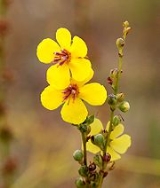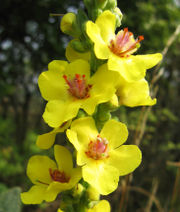
Mullein
Encyclopedia
The Mulleins are a genus of about 250 species of flowering plant
s in the figwort family (Scrophulariaceae
). They are native to Europe
and Asia
, with the highest species diversity in the Mediterranean region.
They are biennial
or perennial plant
s, rarely annuals
or subshrub
s, growing to 0.5–3 m tall. The plants first form a dense rosette of leaves
at ground level, subsequently sending up a tall flowering stem. Biennial plants will form the rosette the first year, and during the following season is when the stem emerges. The leaves are spirally arranged, often densely hairy, though glabrous (hairless) in some species. The flower
s have five symmetrical petals; petal colours in different species include yellow (most common), orange, red-brown, purple, blue or white. The fruit
is a capsule
containing numerous minute seed
s.
 Various species have been introduced (and in some case naturalised
Various species have been introduced (and in some case naturalised
) in the Americas
, Australia
and Hawaii
.
The plant has a long history of use as an herbal remedy, and is an effective treatment for asthma
and respiratory disorders. Extracts made from the plant's flowers are a very effective treatment for ear infections. Although this plant is a recent arrival to North America, Native Americans used the ground seeds of this plant as a paralytic fish poison due to their high levels of rotenone
. One species, Verbascum thapsus (Great mullein), is used as a herb
al remedy for sore throat
, cough
, and lung
diseases.
In gardening and landscaping, the mulleins are valued for their tall narrow stature and for flowering over a long period of time, even in dry soils. Since the year 2000, a number of new hybrid cultivar
s have come out that have increased flower size, shorter heights, and a tendency to be longer-lived plants. A number have new colors for this genus
. Many mulleins are raised from seed, including both the short-lived perennial and biennial
types.
Mullein is the active ingredient
in many alternative smoking blends.
It is considered a first-rate drill for use in the hand drill method of friction fire lighting.
}}
Flowering plant
The flowering plants , also known as Angiospermae or Magnoliophyta, are the most diverse group of land plants. Angiosperms are seed-producing plants like the gymnosperms and can be distinguished from the gymnosperms by a series of synapomorphies...
s in the figwort family (Scrophulariaceae
Scrophulariaceae
Scrophulariaceae, the figwort family, are a family of flowering plants. The plants are annual or perennial herbs with flowers with bilateral or rarely radial symmetry. Members of the Scrophulariaceae have a cosmopolitan distribution, with the majority found in temperate areas, including...
). They are native to Europe
Europe
Europe is, by convention, one of the world's seven continents. Comprising the westernmost peninsula of Eurasia, Europe is generally 'divided' from Asia to its east by the watershed divides of the Ural and Caucasus Mountains, the Ural River, the Caspian and Black Seas, and the waterways connecting...
and Asia
Asia
Asia is the world's largest and most populous continent, located primarily in the eastern and northern hemispheres. It covers 8.7% of the Earth's total surface area and with approximately 3.879 billion people, it hosts 60% of the world's current human population...
, with the highest species diversity in the Mediterranean region.
They are biennial
Biennial plant
A biennial plant is a flowering plant that takes two years to complete its biological lifecycle. In the first year the plant grows leaves, stems, and roots , then it enters a period of dormancy over the colder months. Usually the stem remains very short and the leaves are low to the ground, forming...
or perennial plant
Perennial plant
A perennial plant or simply perennial is a plant that lives for more than two years. The term is often used to differentiate a plant from shorter lived annuals and biennials. The term is sometimes misused by commercial gardeners or horticulturalists to describe only herbaceous perennials...
s, rarely annuals
Annual plant
An annual plant is a plant that usually germinates, flowers, and dies in a year or season. True annuals will only live longer than a year if they are prevented from setting seed...
or subshrub
Subshrub
A subshrub or dwarf shrub is a short woody plant. Prostrate shrub is a similar term.It is distinguished from a shrub by its ground-hugging stems and lower height, with overwintering perennial woody growth typically less than 10–20 cm tall, or by being only weakly woody and/or persisting...
s, growing to 0.5–3 m tall. The plants first form a dense rosette of leaves
Leaf
A leaf is an organ of a vascular plant, as defined in botanical terms, and in particular in plant morphology. Foliage is a mass noun that refers to leaves as a feature of plants....
at ground level, subsequently sending up a tall flowering stem. Biennial plants will form the rosette the first year, and during the following season is when the stem emerges. The leaves are spirally arranged, often densely hairy, though glabrous (hairless) in some species. The flower
Flower
A flower, sometimes known as a bloom or blossom, is the reproductive structure found in flowering plants . The biological function of a flower is to effect reproduction, usually by providing a mechanism for the union of sperm with eggs...
s have five symmetrical petals; petal colours in different species include yellow (most common), orange, red-brown, purple, blue or white. The fruit
Fruit
In broad terms, a fruit is a structure of a plant that contains its seeds.The term has different meanings dependent on context. In non-technical usage, such as food preparation, fruit normally means the fleshy seed-associated structures of certain plants that are sweet and edible in the raw state,...
is a capsule
Capsule (fruit)
In botany a capsule is a type of simple, dry fruit produced by many species of flowering plants. A capsule is a structure composed of two or more carpels that in most cases is dehiscent, i.e. at maturity, it splits apart to release the seeds within. A few capsules are indehiscent, for example...
containing numerous minute seed
Seed
A seed is a small embryonic plant enclosed in a covering called the seed coat, usually with some stored food. It is the product of the ripened ovule of gymnosperm and angiosperm plants which occurs after fertilization and some growth within the mother plant...
s.
Selected species
|
Verbascum nigrum Verbascum nigrum L. is a species of biennial or short-lived perennial herbaceous plants in the genus Verbascum , native to dry open sites in Europe and the Mediterranean region. It grows to 0.5-1.5 m.-External links:*... L. – Dark mullein Verbascum speciosum Verbascum speciosum is a species of flowering plant in the figwort family known by the common name showy mullein. It is native to eastern Europe and western Asia, and it is known in many other regions as an introduced species and roadside weed. It is a biennial herb forming a rosette of large... Schrad. – Showy mullein Verbascum virgatum Verbascum virgatum, commonly known as Twiggy Mullein and Wand Mullein, is a plant species in the family Scrophulariaceae.-Description:... Stokes – Twiggy mullein |
Cultivation and uses

Naturalisation (biology)
In biology, naturalisation is any process by which a non-native organism spreads into the wild and its reproduction is sufficient to maintain its population. Such populations are said to be naturalised....
) in the Americas
Americas
The Americas, or America , are lands in the Western hemisphere, also known as the New World. In English, the plural form the Americas is often used to refer to the landmasses of North America and South America with their associated islands and regions, while the singular form America is primarily...
, Australia
Australia
Australia , officially the Commonwealth of Australia, is a country in the Southern Hemisphere comprising the mainland of the Australian continent, the island of Tasmania, and numerous smaller islands in the Indian and Pacific Oceans. It is the world's sixth-largest country by total area...
and Hawaii
Hawaii
Hawaii is the newest of the 50 U.S. states , and is the only U.S. state made up entirely of islands. It is the northernmost island group in Polynesia, occupying most of an archipelago in the central Pacific Ocean, southwest of the continental United States, southeast of Japan, and northeast of...
.
The plant has a long history of use as an herbal remedy, and is an effective treatment for asthma
Asthma
Asthma is the common chronic inflammatory disease of the airways characterized by variable and recurring symptoms, reversible airflow obstruction, and bronchospasm. Symptoms include wheezing, coughing, chest tightness, and shortness of breath...
and respiratory disorders. Extracts made from the plant's flowers are a very effective treatment for ear infections. Although this plant is a recent arrival to North America, Native Americans used the ground seeds of this plant as a paralytic fish poison due to their high levels of rotenone
Rotenone
Rotenone is an odorless chemical that is used as a broad-spectrum insecticide, piscicide, and pesticide. It occurs naturally in the roots and stems of several plants such as the jicama vine plant...
. One species, Verbascum thapsus (Great mullein), is used as a herb
Herb
Except in botanical usage, an herb is "any plant with leaves, seeds, or flowers used for flavoring, food, medicine, or perfume" or "a part of such a plant as used in cooking"...
al remedy for sore throat
Sore throat
A sore throat or throat pain is a common physical symptom usually caused by acute pharyngitis, or throat inflammation, though it also occurs in a number of other situations, such as post trauma and in diphtheria. It can cause mild to extreme pain....
, cough
Cough
A cough is a sudden and often repetitively occurring reflex which helps to clear the large breathing passages from secretions, irritants, foreign particles and microbes...
, and lung
Lung
The lung is the essential respiration organ in many air-breathing animals, including most tetrapods, a few fish and a few snails. In mammals and the more complex life forms, the two lungs are located near the backbone on either side of the heart...
diseases.
In gardening and landscaping, the mulleins are valued for their tall narrow stature and for flowering over a long period of time, even in dry soils. Since the year 2000, a number of new hybrid cultivar
Cultivar
A cultivar'Cultivar has two meanings as explained under Formal definition. When used in reference to a taxon, the word does not apply to an individual plant but to all those plants sharing the unique characteristics that define the cultivar. is a plant or group of plants selected for desirable...
s have come out that have increased flower size, shorter heights, and a tendency to be longer-lived plants. A number have new colors for this genus
Genus
In biology, a genus is a low-level taxonomic rank used in the biological classification of living and fossil organisms, which is an example of definition by genus and differentia...
. Many mulleins are raised from seed, including both the short-lived perennial and biennial
Biennial plant
A biennial plant is a flowering plant that takes two years to complete its biological lifecycle. In the first year the plant grows leaves, stems, and roots , then it enters a period of dormancy over the colder months. Usually the stem remains very short and the leaves are low to the ground, forming...
types.
Mullein is the active ingredient
Active ingredient
An active ingredient is the substance of a pharmaceutical drug or a pharmaceutical ingredient and bulk active in medicine; in pesticide formulations active substance may be used. Some medications and pesticide products may contain more than one active ingredient...
in many alternative smoking blends.
It is considered a first-rate drill for use in the hand drill method of friction fire lighting.
External links
}}

